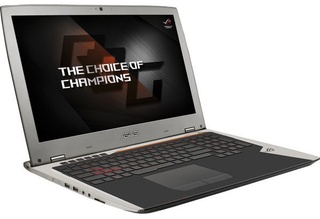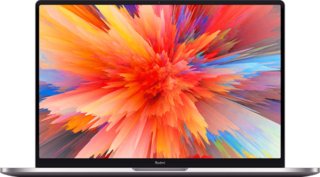Asus ROG GX700 17.3" Intel Core i7 6820HK vs Xiaomi RedmiBook Pro 14 Intel Core i5-1135G7
The Asus ROG GX700, equipped with an Intel Core i7 processor and an impressive 64GB of RAM, caters to gamers and power users in need of strong performance. In contrast, the RedmiBook Pro 14 operates on an Intel Core i5 processor and features a sleek, portable design, making it ideal for users prioritizing mobility alongside performance.
In terms of performance, the Asus ROG GX700 surpasses many with its outstanding processor and abundant RAM. This titan is intended for those who require intensive tasks. However, if portability strikes your fancy, the streamlined design of the RedmiBook Pro 14 is perfect for use in transit. The ROG GX700 will appeal to gamers and those who prioritize high-performance, while the RedmiBook Pro 14 is a fit for those desiring a mix of strength and portability.
Both models offer distinct advantages that ensure you find just the right fit based on your specific requirements.
System and application performance
Performance in popular 3D games
Viewing angle, color accuracy...
Ports, webcam and other interfaces
Potential battery life
Materials, durability and portability
Design Comparison
Size Comparison
When comparing the Asus ROG GX700 and Xiaomi RedmiBook Pro 14 in terms of design elements that enhance user experience, several factors come into play:
Design Elements Influencing User Experience:
- Weight and Portability:
- The Xiaomi RedmiBook Pro 14 weighs 3.2 pounds, much lighter than the Asus ROG GX700 at 7.9 pounds, enhancing its portability for students and professionals needing a laptop on the move.
- Dimensions:The RedmiBook Pro 14 stands out for its slim and compact design, measuring 12.4 x 8.7 x 0.7 inches, a notable contrast to the larger Asus ROG GX700 sizing in at 16.8 x 12.1 x 1.3 inches. Its more petite build allows for convenient portability and effortless use even in confined areas.
- Build Quality and Materials:
- Both laptops have a backlit keyboard to improve usability in low-light conditions, but they vary in material choice. The Asus ROG GX700 may provide a sturdier build quality suitable for gaming enthusiasts, while the RedmiBook Pro 14's elegant design may attract professionals seeking a stylish and functional device.
- Connectivity Options:
- Both laptops feature key connectivity options like HDMI output, USB Type-C ports, Wi-Fi support, external memory slots, and headphone jacks. The RedmiBook Pro 14, in particular, distinguishes itself with extra USB ports (4) and Bluetooth version 5.1, ideal for users needing to connect multiple peripherals.
- Ergonomics and User Comfort:
- Both laptops are designed with user-friendly features such as front cameras, stereo speakers, audio jacks, and sleep-and-charge USB ports for improved user experience during video calls, multimedia consumption, or device charging.
- Unique Design Features:
- The Xiaomi RedmiBook Pro 14 offers a fingerprint scanner for added security and convenience along with features like voice commands and multiple microphones that can benefit professionals needing quick access and efficient communication tools.
User Needs Consideration:
- *Students:* The Xiaomi RedmiBook Pro 14's sleek and portable design makes it a perfect choice for students requiring a laptop for classes, projects, or study groups on campus.
- *Professionals:* Those who aim to balance performance and portability may find the sleek design of the RedmiBook Pro 14 appealing, with additional features such as fingerprint scanning to boost security.
Conclusion:
In conclusion, the Asus ROG GX700 is ideal for gamers with its sturdy construction and spacious screen, whereas the Xiaomi RedmiBook Pro 14 appeals to students or professionals looking for a sleek, portable device with added features.
Screen Comparison
| Asus ROG GX700 17.3" Intel Core i7 6820HK | Xiaomi RedmiBook Pro 14 Intel Core i5-1135G7 | |
|---|---|---|
| Resolution | 4K | QHD |
When you look at the screens of the Asus ROG GX700 17.3" and the Xiaomi RedmiBook Pro 14, there are important factors to consider for your user experience, especially for gaming or professional graphic design. Let's explore their screen features to assist you in making a well-informed choice:
Screen Size:
- Asus ROG GX700 (17.3 inches):-Provides a larger screen space, enhancing the gaming experience or improving productivity for graphic design tasks.
- Xiaomi RedmiBook Pro (14 inches):
- The compact size enhances portability, making it convenient for on-the-go productivity.
Resolution:
- Asus ROG GX700 (3840 x 1080 px):
- High resolution allows for sharp details and crisp visuals, especially advantageous in gaming where intricate textures and effects are prevalent.
- Xiaomi RedmiBook Pro (2560 x 1440 px):
- Although slightly lower resolution than the Asus model, still offers good clarity suitable for most tasks like content creation and media consumption.
Pixel Density:
- Asus ROG GX700 (259 ppi):
- Higher pixel density results in smoother images with less visible pixelation, enhancing visual quality during gaming or designing.
- Xiaomi RedmiBook Pro (216 ppi):
- Slightly lower pixel density but still delivers clear visuals for everyday use.
Display Type:
- Both laptops come with IPS LCD LED-backlit displays that deliver vibrant colors, wide viewing angles, and energy efficiency. This guarantees reliable and precise color reproduction essential for activities such as photo editing or gaming.
Anti Reflection Coating:
- Both laptops come with anti-glare coating to minimize reflections and enhance visibility in different lighting situations, which proves useful for tasks conducted outdoors or in well-lit settings.
Brightness & Contrast Ratio:
- Xiaomi RedmiBook Pro:
- Specifies brightness level at 300 nits and contrast ratio of 1000:1, demonstrating strong display performance in terms of brightness and color differentiation.
In conclusion, the Asus ROG GX700's larger screen size, higher resolution, and pixel density create an immersive gaming experience or support demanding graphic design work that needs top-tier visual performance. On the flip side, the Xiaomi RedmiBook Pro's compact design and decent display specs suit everyday computing tasks with clear visuals.
Hardware Comparison
| Asus ROG GX700 17.3" Intel Core i7 6820HK | Xiaomi RedmiBook Pro 14 Intel Core i5-1135G7 | |
|---|---|---|
| CPU | Intel Core i7 | Intel Core i5-1135G7 |
| RAM | 64GB | 16GB |
| Storage Size | 1000GB | 512GB |
When comparing the hardware of the Asus ROG GX700 and the Xiaomi RedmiBook Pro 14, it's essential to consider key components to choose the best laptop for your needs. Let's explore the specifics:
CPU (Central Processing Unit)
- Asus ROG GX700: Features an Intel Core i7 6820HK processor running at 2.7GHz.
- Xiaomi RedmiBook Pro 14: Features an Intel Core i5-1135G7 processor clocked at 2.4GHz.
Performance Comparison: The Asus ROG GX700 stands out for its Intel Core i7 processor that delivers superior performance when compared to the Xiaomi RedmiBook Pro 14's Intel Core i5 processor. This results in enhanced multitasking abilities, quicker processing speeds, and superior performance, especially in demanding tasks such as video editing and gaming.
GPU (Graphics Processing Unit)
- Asus ROG GX700: GPU information not provided
- Xiaomi RedmiBook Pro 14: Integrated Graphics
Performance Impact: The Xiaomi RedmiBook Pro 14 may have limited graphical capabilities due to its integrated graphics, which could impact gaming performance and graphic-intensive tasks when compared to laptops featuring a dedicated GPU.
RAM (Random Access Memory)
- Asus ROG GX700: 64GB RAM
- Xiaomi RedmiBook Pro 14: 16GB RAM
Performance Impact: With its impressive 64GB RAM, the Asus ROG GX700 excels in handling memory-intensive applications and multitasking, catering to power users and content creators. On the other hand, while the Xiaomi RedmiBook Pro 14 offers a decent 16GB RAM suitable for daily tasks, it may face challenges with heavy multitasking or demanding software.
Storage
- Asus ROG GX700: 1TB internal storage
- Xiaomi RedmiBook Pro 14: 512GB SSD
Performance Impact: The Asus ROG GX700 offers abundant storage space for large multimedia files and games, ensuring you won't run out of space quickly. Meanwhile, the Xiaomi RedmiBook Pro's smaller SSD storage provides faster boot times and application loading speeds, although it may necessitate external storage for extensive file libraries.
Practical Applications
- For tasks like video editing, gaming, or running resource-heavy software:
- The Asus ROG GX700 impresses with its powerful CPU and generous RAM.
- The Xiaomi RedmiBook Pro is ideal for daily tasks and light content creation, though it may face challenges with more demanding applications.
In summary, for exceptional gaming or professional tasks requiring substantial processing power and memory, the Asus ROG GX700 is a reliable option. On the other hand, if you are looking for a cost-effective laptop for daily productivity tasks with good performance, consider the Xiaomi RedmiBook Pro 14.
Verdict
Why Asus ROG GX700 17.3" Intel Core i7 6820HK?
- Superior performance with Intel Core i7 processor and massive 64GB RAM.
- Ideal for gamers and heavy-duty users needing robust performance.
- Spacious 17.3" screen size enhancing gaming and productivity experience.
Why ?
- Portability and sleek design, ideal for on-the-go users prioritizing mobility.
- Cost-effective option for daily productivity tasks without compromising performance.
- Fingerprint scanner and added security features enhance user convenience and device protection.
Similar comparisons
- Asus ROG Flow Z13 (2022) GZ301 13.4" Intel Core i5-12500H vs Lenovo IdeaPad Y700 15 15.6" Intel Core i7-6700HQ
- Asus ROG Flow X16 (2023) 16" QHD Plus Intel Core i9-13900H vs Samsung Galaxy Book3 Ultra 16" Intel Core i9-13900H
- Asus R558UR 15.6" Intel Core i5 6200U vs Asus Vivobook 15 X515JA 15.6" Intel Core i5-1035G1
- Asus D550CA RS31 15.6" Intel Core i3-3217U vs Dell XPS 13 9350 13.3" Intel Core i5 6200U
- Asus F555UA 15.6" Intel Core i7 6500U vs Asus VivoBook 15 X512UF Intel Core i5-8250U

